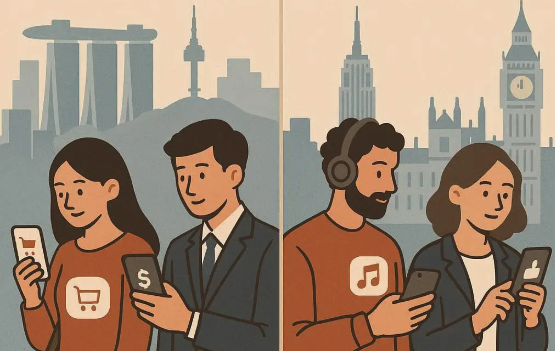The Global Spread of Superapps | 매거진에 참여하세요
The Global Spread of Superapps
#Superapps #Definition #Asia #Grab #Kakao #Finance #Lifestyle #X #Reference
The Concept of Superapps and Their Success in Asia
A superapp is a single application that integrates multiple services such as messaging, payments, shopping, delivery, and mobility.
Examples include WeChat in China, Grab in Southeast Asia, Kakao in Korea, and Paytm in India.
Users can handle almost all daily life tasks within one app, turning it from a mere “app ecosystem” into a digital life infrastructure.
While highly successful in Asia, superapps have yet to gain a strong foothold in North America and Europe.
The key question in the IT industry today:
“Can the superapp model go global?”
Why Superapps Succeed in Asia
1. Mobile-first Internet growth
Many Asian markets leapfrogged PC-based internet, growing directly in mobile-first environments.
Consolidating multiple services into one app was logical.
2. Low financial infrastructure → mobile payments boom
In regions with low bank account or credit card penetration, superapps provided mobile wallets, drastically improving financial accessibility.
3. Economies of scale & network effects
Messenger-based apps amassed huge user bases, layering services on top to maximize synergy.
4. Government & regulatory environment
Some Asian governments encouraged big tech firms to serve as everyday infrastructure, rather than imposing restrictive regulations.

Why Superapps Haven’t Spread in the West
Strong specialized apps
North America and Europe already have dominant apps like Uber, PayPal, Amazon, and WhatsApp. Space for a superapp is limited.
Privacy & antitrust regulations
GDPR in Europe and antitrust enforcement in the US create barriers to “all-in-one” apps.
Consumer habits
Western users often prioritize specialized, best-in-class apps and may find all-in-one solutions inconvenient.
Western Attempts at Superapps
X (Elon Musk’s Twitter)
Aims to become an “everything app,” integrating payments, commerce, and content.
PayPal
Expanding beyond payments to investment, shopping, and transfers → moving toward a “financial superapp.”
Uber
Evolving into a “lifestyle service hub” with Uber Eats, mobility, and retail delivery.
These efforts have not yet matched integrated models like WeChat but indicate a gradual push toward superapp features.

Pros and Cons of Global Superapp Adoption
Positive factors
AI & data integration: Generative AI makes seamless user experience across services easier.
Fintech growth: Rising demand for mobile payments and digital wallets supports financial superapps.
Consumer fatigue: Users overwhelmed by too many apps seek consolidation.
Challenges
Regulatory risks: Superapps may trigger anti-monopoly scrutiny.
Cultural differences: Western markets favor competition and specialized services over “all-in-one” solutions.
Asia and Southeast Asia as Key References
WeChat and Kakao
:integrate messaging, mobility, finance, and entertainment, setting the benchmark for global superapps.
Grab and Gojek
:combine transportation, payments, and delivery, serving hundreds of millions of users and becoming reference models for Western markets.
Conclusion: The Future of Superapps Is Hybrid
The Asian superapp model cannot be fully replicated in the West, but service integration is inevitable.
Western markets may see financial superapps (PayPal, Revolut), lifestyle superapps (Uber), and social superapps (X) emerge gradually.
In Asia, superapps have already become digital infrastructure and can aim for global expansion.
Ultimately, superapps will evolve into regionally adapted hybrid models, with Asian experiences providing critical guidance for global strategies.






